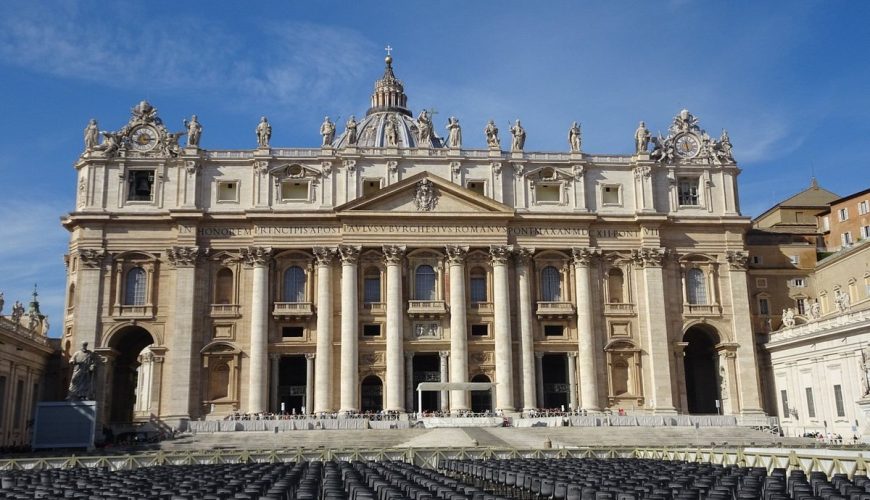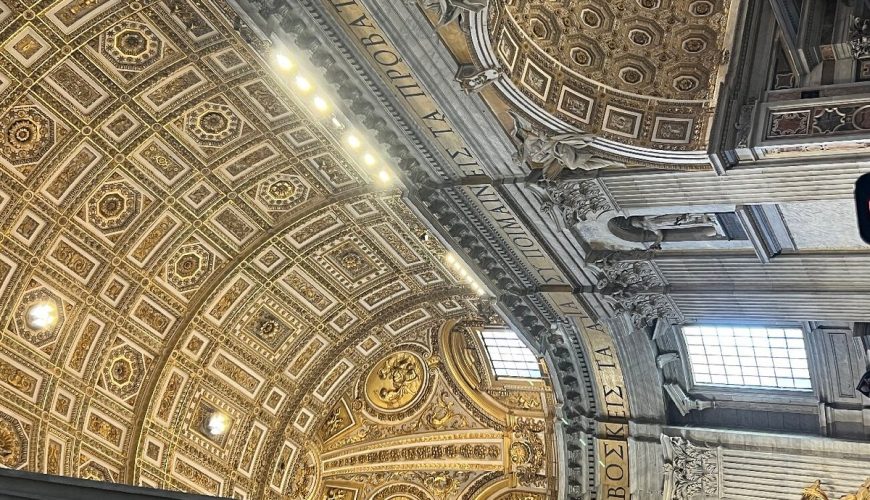St. Peter’s Basilica is located within Vatican City. It is one of the most renowned and architecturally significant churches in the world. It serves as the heart of the Roman Catholic Church and a major pilgrimage site for Christians globally.
Towering over Vatican City, St. Peter’s Basilica isn’t just a church; it’s a masterpiece of Renaissance architecture, a center of Catholicism, and a pilgrimage destination for millions. As you approach St. Peter’s Square, prepare to be awestruck by its sheer scale, captivating art, and rich history. Get ready to embark on a journey through this architectural marvel!
St. Peter’s Basilica Historical Background

The basilica stands on the traditional site where St. Peter, one of Jesus’ twelve apostles and the first pope, was martyred and buried. The original basilica was commissioned by Emperor Constantine the Great in the 4th century.
However, by the 15th century, Pope Julius II decided to embark on an ambitious project – the construction of a new St. Peter’s Basilica that would befit the grandeur of the Catholic Church. Great architects like Michelangelo, Bramante, and Bernini left their mark on the basilica’s design and construction, resulting in a stunning blend of Renaissance and Baroque styles.
Standing before St. Peter’s Basilica, the first thing that grabs your attention is its awe-inspiring facade. A majestic colonnade designed by Bernini embraces the square, creating a sense of welcome. Look closer and admire the intricate sculptures of saints adorning the facade, each one a testament to the artistry and devotion poured into this basilica.
St. Peter’s Basilica Architecture and Design

Exterior
The facade of St. Peter’s Basilica, designed by Carlo Maderno, is a striking example of Renaissance and Baroque architecture. It features colossal columns and pilasters, statues of Christ, apostles, and saints, and an imposing central pediment. The grand staircase leading up to the entrance, coupled with the expansive St. Peter’s Square designed by Bernini, creates a dramatic approach to the basilica.
Dome
One of the most iconic features of St. Peter’s Basilica is its dome, designed by Michelangelo. The dome, which rises to a height of approximately 136.5 meters (448 feet), dominates the skyline of Rome. It is considered one of the greatest engineering feats of the Renaissance. Visitors can ascend to the top of the dome, where they are rewarded with panoramic views of Vatican City and Rome.
Interior
The interior of the basilica is equally breathtaking. It covers approximately 15,160 square meters (163,000 square feet) and can accommodate over 60,000 people. The nave is flanked by enormous marble columns and illuminated by light filtering through intricately designed windows. The high altar, located directly above St. Peter’s tomb, is reserved for the Pope and is adorned with Bernini’s magnificent bronze baldachin, or canopy.
Artistic Masterpieces
St. Peter’s Basilica houses an array of artistic treasures. Among the most famous is Michelangelo’s “Pieta,” a marble sculpture depicting the Virgin Mary cradling the body of Jesus. This masterpiece is located in the first chapel on the right as one enters the basilica. The basilica also features numerous chapels, altars, and mosaics created by renowned artists over the centuries.
Religious and Cultural Significance

St. Peter’s Basilica is not only an architectural marvel but also a vital religious site. It is the primary church of the Pope, the leader of the worldwide Catholic Church, and a central place of worship and pilgrimage. Major liturgical events, including papal masses, canonizations, and solemn ceremonies, are held here.
A Center of Faith
Beyond its artistic grandeur, St. Peter’s Basilica is a living church. Witness a Papal Mass, a solemn and awe-inspiring ceremony, or simply sit in quiet contemplation, soaking in the atmosphere of this holy place. For millions of Catholics, St. Peter’s Basilica represents the heart of their faith, a place of pilgrimage and prayer.
St. Peter’s Basilica stands as a testament to human ingenuity, artistic achievement, and religious devotion. Its grand architecture, rich history, and cultural significance make it a must-visit landmark for millions of people each year. Whether for spiritual enrichment, artistic appreciation, or historical curiosity, a visit to St. Peter’s Basilica offers a profound and unforgettable experience.
A Must-See for Any Visitor
Whether you’re a Catholic pilgrim or simply an art enthusiast, St. Peter’s Basilica is a must-see on any trip to Rome or Vatican City. It’s a place where history, art, and faith come together to create a truly awe-inspiring experience.
Plan Your Visit
Dress modestly when visiting St. Peter’s Basilica, as it’s a functioning church. Be prepared for crowds, especially during peak season. Free guided tours are available, offering valuable insights into the basilica’s art and history.
A Beacon of Catholicism
St. Peter’s Basilica stands as a testament to the enduring power of faith and the artistic genius that humanity can achieve. So, next time you find yourself in Vatican City, take a moment to appreciate the grandeur of St. Peter’s Basilica and the stories it whispers within its walls.









0 Comment